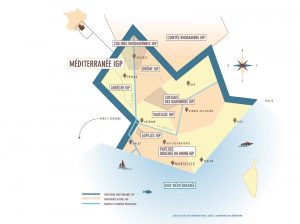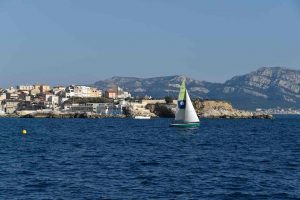Historically famous for their blended (or assemblage) wines, Provence and the Rhône valley, in south-eastern France also offer a wide and diverse range of IGP denominations. When creating their range of wine or structuring their vineyard, producers can choose an IGP denomination for the diversity of grape varieties and creative freedom these allow.
IGP, or Indication Géographique Protégée, took the place of the old Vin de Pays regional classification in 2009 and is now the way through which producers can guarantee the geographic provenance of their wine. The identity of each IGP represents not only the area within which a wine is produced, but also the quality, reputation, winemaking style and grapes used. The IGP classification is known for its flexibility, allowing for great experimentation and creativity with blends and winemaking approaches.
Combined, the IGPs of south-eastern France produce over a third of the area’s wine and form an integral part of its viticultural wealth.
There are nine IGPs in total. The Méditerranée IGP covers the south, overlapping the more localised areas of Alpilles IGP, Pays des Bouches du Rhône IGP, Vaucluse IGP and Coteaux des Baronnies IGP. All these are marked by a strong Mediterranean influence.
To the North one finds the Comtés Rhodaniens IGP, within which are the Ardèche IGP, Collines Rhodaniennes IGP (‘hills of the Rhône’ in French) and Drôme IGP. With a more continental climate, influenced by the Massif Centrale, these denominations range from small and localised (such as Alpilles IGP with 435 hectares) to wide-reaching and flexible (such as the Ardèche IGP with 7,000 hectares and Méditerranée IGP with 11,000 hectares).
The variety within and between them can be stunning – from the windswept, mountainous Coteaux des Baronnies in the Drôme, sitting at 600m altitude with vineyards intermingled with apricot orchards and olive groves, to the gorges of the Ardèche, the Mont Ventoux massif, the natural park, mountains and Festival of the Vaucluse, the artistic centres of Arles and Les Baux in les Alpilles, all the way down to the Camargue’s coastal vines in the marshy Rhône delta near Marseille. The proximity to the Mediterranean offers a gentle, temperate climate as opposed to a more continental influence in the northern Comtés Rhodaniens and Collines Rhodaniennes IGPs, just south of Lyon. This diversity balanced by climatic factors that tie the region together, such as the cool, maritime Marin wind and the Rhône’s famous Mistral, which both keep the vineyards dry and healthy throughout the South-East. The area is famed for its number sunshine hours, especially nearer the Mediterranean.

The region is built of a network of over 6,000 dynamic vignerons and vigneronnes who supply fruit and wines to over 900 private estates, 120 cooperatives and 150 négociants. This thriving community, with members ranging from small boutique estates to large growers, produces a tenth of France’s IGP wines combining quality with volume
Over 260 grape varieties are permitted in the combined IGPs. These include both international varieties (Chardonnay, Sauvignon Blanc, Pinot Noir, Cabernet Sauvignon and Merlot) and regional varieties such as Syrah, Grenache and Viognier. Grenache, Merlot, Syrah and Chardonnay are the most popular. There are also rare, indigenous varieties experiencing a local revival, such as Ardèche’s Chatus, rediscovered in the 90s, or Caladoc in the South.
Whilst overall production is split between red (35%), rosé (51%), and white (14%), there are strong geographic variations. The northern Rhône is ‘Syrah country’ with red wines dominating the small Collines Rhodaniennes IGP (590ha, 66% red), whilst in the southern Pays des Bouches-du-Rhône IGP and Alpilles IGP, rosé rules (64% and 60% respectively). Reflecting its growing popularity, production of rosé has increased in recent years.
Many terroirs offer a flexible testground for winemakers curious about the potential of new and indigenous varieties, both red and white, such as Chasan, Caladoc or Marselan.

South-Eastern of France has built its name upon blends, getting the best from the traditional local varieties. IGP wines are no exception. The majority (96%) of these wines are accessible blends, many of which make the most of the freedom allowed by the IGPs’ regulations to include creative pairings rarely seen elsewhere, such as Cabernet Sauvignon and Grenache, or Viognier and Syrah.
IGP wines from the South-East are appreciated in France for their good value and easy-drinking appeal. Though perhaps less-well known elsewhere, they are worth looking for and can easily becoming your go-to, everyday drinking favourites!
 South-Eastern France IGPs are represented by Intervins Sud-Est, a multi-party association charged with representing and promoting the regions’s wines with Indication Géographique Protégée (French for “Protected Geographical Indication”). The institution represents 1224 companies, 7500 women and men, 1250 000 hectolitres of wines produced each year and 21000 hectares under vine.
South-Eastern France IGPs are represented by Intervins Sud-Est, a multi-party association charged with representing and promoting the regions’s wines with Indication Géographique Protégée (French for “Protected Geographical Indication”). The institution represents 1224 companies, 7500 women and men, 1250 000 hectolitres of wines produced each year and 21000 hectares under vine.
The latter cover a large territory, composed of 9 IGP denominations in 10 departments: Alpilles IGP, Ardèche IGP, Collines Rhodaniennes IGP, Coteaux des Baronnies IGP, Comtés Rhodaniens IGP, Drôme IGP, Méditerranée IGP, Pays des Bouches du Rhône IGP, Vaucluse IGP. The association brings together producers (both private estates and cooperatives) and négociants. It provides a global vision of the sector’s economy and enables actions to be taken in the collective interest: communication of the denominations, research and development, downstream quality monitoring, etc.







